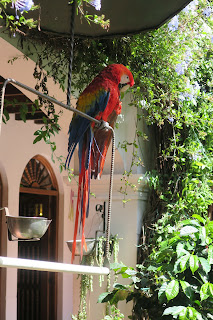The Hotel Santo Tomas is an idyllic Hotel in the famous “Quiche Village” of
Chichicastenango. It is located just a few minutes stroll from the Indian
Market and the Church of Santo Tomas. The Hotel Santo Tomas is an attractive
place that features a collection of Spanish colonial art, beautiful flowers
and exotic birds. The Hotel Santo Tomas has forty-three spacious rooms with
fireplaces and all of them are individually decorated. Their restaurant
overlooks the courtyard and serves good local and international meals.
|
Scarlet macaw.
The scarlet macaw (Ara macao) is a large yellow, red and blue
Central and South American parrot, a member of a large group of
Neotropical parrots called macaws.
- It is native to humid evergreen forests of the Neotropics.
-
Its range extends from south-eastern Mexico to Peru, Ecuador,
Colombia, Bolivia, Venezuela and Brazil in lowlands of 500 m (1,600
ft) (at least formerly) up to 1,000 m (3,300 ft), the Caribbean island
of Trinidad, as well as the Pacific island of Coiba.
-
See more at
Scarlet macaw - Wikipedia.
|
|
Northern mealy amazon.
The northern mealy amazon or northern mealy parrot (Amazona guatemalae) is among the largest parrots in the genus Amazona, the amazon
parrots. It is a mainly green parrot with a total length of 38–41 cm
(15–16 in). It is endemic to tropical Central America.
-
Two subspecies have been described and these have alternative common
names that are used frequently in aviculture: 1)
A. g. guatemalae: Found from southeastern Mexico to Honduras.
Also known as the blue-crowned mealy amazon or the Guatemalan amazon,
2) A. g. virenticeps: Found in Nicaragua to western Panama.
Also known as the Costa Rican mealy amazon or the green-headed amazon.
-
See more at
Northern mealy amazon - Wikipedia.
|
|
Traditional Guatemalan Wooden Masks.
In Guatemala, masks have been made and worn for millennia. Over this
time they have undergone numerous adaptations in the ways they are made,
what they represent and how they are used. Masks continue to play an
important role in ceremonies, rituals and performances today.
|
|
Dolls painted in the traditional Guatemalan costume.
Huipil is the most common traditional garment worn by indigenous women
from central Mexico to Central America.
-
It is a loose-fitting tunic, generally made from two or three
rectangular pieces of fabric, which are then joined with stitching,
ribbons, or fabric strips, with an opening for the head and, if the
sides are sewn, openings for the arms. Traditional huipils, especially
ceremonial ones, are usually made with fabric woven on a backstrap
loom and are decorated with designs woven into the fabric, embroidery,
ribbons, lace, and more. However, some huipils are also made from
commercial fabric.
-
A huipil can vary in length from a short blouse to a garment long
enough to reach the floor. The style of traditional huipils generally
indicates the ethnicity and community of the wearer as each has its
own methods of creating the fabric and decorations. Ceremonial huipils
are suitable for weddings, burials, women of high rank and even to
dress the statues of saints.
-
The huipil has been worn by indigenous Mesoamerican women of both high
and low social rank since well before the Spanish invasion. A
characteristic item of Aztec clothing, it remains the most common
female indigenous garment still in use. It is most often seen in the
Mexican states of Chiapas, Yucatán, Quintana Roo, Oaxaca, Tabasco,
Campeche, Hidalgo, Michoacán (where it is called a huanengo),
Veracruz and Morelos. In Central America it is most often used among
the Mayas in Guatemala.
-
See more at
Huipil - Wikipedia.
|
|
Trinity wood carving.
The Trinity is most commonly seen in Christian art with the Holy Spirit
represented by a dove, as specified in the gospel accounts of the
baptism of Christ; he is nearly always shown with wings outspread.
However depictions using three anthropomorphic figures appear
occasionally in most periods of art.
-
By the end of the 15th century, larger representations became
effectively standardised, showing an older figure in plain robes for
the Father, Christ with his torso partly bare to display the wounds of
his Passion, and the dove above or around them.
-
In earlier representations both Father, especially, and Son often wear
elaborate robes and crowns. Sometimes the Father alone wears a crown,
or even a papal tiara.
-
See more at
The Trinity in art - Wikipedia.
|
|
Entrance doors to the rooms.
|
|
Interior of one of the rooms.
|
See also
Source
Location




























